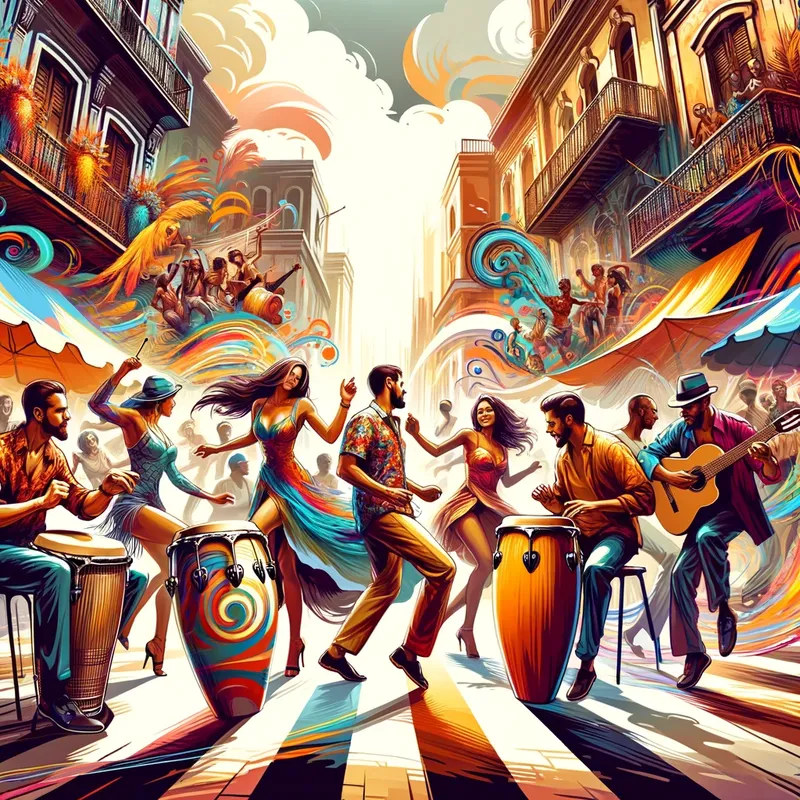Latin Jazz is essentially a marriage between jazz, born in the United States, and the passionate rhythms of Latin America.
Think Afro-Cuban, Brazilian, Puerto Rican, and other Latin American influences meeting the complex improvisations of jazz. The result? A sound that’s as electrifying as it is emotive.
With Latin Jazz, you get the best of both worlds: the intricate solos and harmonic sophistication of jazz, combined with the rhythmic vitality of Latin music.
Table of Contents
A Brief History
The fusion of Latin and jazz influences dates back as far as the 1940s, and we’ve got the Afro-Cuban movement to thank for that. Artists like Dizzy Gillespie and Machito were at the forefront, blending elements of bebop with Afro-Cuban rhythms. But let’s not forget Brazil! The bossa nova and samba waves brought a whole new flavor, adding to the existing melting pot.
Legends of the Latin Jazz Scene
So who are the key players that have been setting the stage ablaze? Names like Tito Puente, Dizzy Gillespie, and Antonio Carlos Jobim are indispensable. More contemporary maestros include Chucho Valdés and Poncho Sanchez. These musicians have been crucial in developing Latin Jazz.
The Instruments
In Latin Jazz, the instrumentation often goes beyond the standard jazz ensemble. You’ll see traditional jazz instruments like the saxophone, trumpet, and piano. But the Latin influence brings in a wealth of percussive elements. We’re talking congas, bongos, timbales, and even the occasional güiro for that raspy texture. These instruments provide the unique rhythms that make Latin Jazz so irresistibly danceable.
Styles Within the Style: The Many Faces of Latin Jazz
There are several sub-genres within Latin Jazz itself, each with its own flair and rhythmic patterns. Afro-Cuban Jazz, Brazilian Jazz, and Latin Soul Jazz are just a few examples. Each sub-genre brings its own unique rhythm and cultural background to the mix.
Why You Should Be Listening to Latin Jazz
If the infectious rhythms and soul-stirring melodies aren’t enough to convince you, consider this:
- Expand Your Horizons: Latin Jazz is like a crash course in world culture, all set to a rhythm you can’t help but move to.
- Emotional Depth: The fusion of jazz and Latin elements produces a rich emotional tapestry.
- Technical Brilliance: If you’re a musician or just someone who appreciates skill, the genre is a goldmine of technical prowess.
FAQ
What is Latin Jazz?
Latin Jazz is a musical genre that combines the complexity of jazz with the rhythmic elements and instruments of Latin American music.
Who Invented Latin Jazz?
While it’s tough to pin it on one person, pioneers like Dizzy Gillespie and Machito were instrumental in blending jazz with Afro-Cuban rhythms back in the ’40s.
Is Latin Jazz Just Jazz with Maracas?
No way. It’s a lot more complex than that. Sure, Latin Jazz incorporates Latin percussion like maracas, congas, and bongos, but it also involves intricate improvisation, harmonic sophistication, and a variety of unique rhythms from different Latin American cultures.
Who are Some Must-Listen Latin Jazz Musicians?
Old-school legends include Tito Puente and Antonio Carlos Jobim, while modern maestros like Chucho Valdés and Poncho Sanchez are flying the flag today. Dig into their music, and you’ll get a well-rounded Latin Jazz education!
How Can I Start Listening to Latin Jazz?
A great way to dive in is through streaming services. Look for playlists that focus on Latin Jazz, or start with some of the big names we mentioned earlier.
Is Latin Jazz Good for Dancing?
Latin Jazz rhythms are made for dancing! Whether it’s a simple two-step or a full-on salsa spin, this music will get you moving.
Any Recommendations for a Latin Jazz Playlist?
Try out:
“Oye Como Va” by Tito Puente
“Manteca” by Dizzy Gillespie
“The Girl from Ipanema” by Antonio Carlos Jobim


